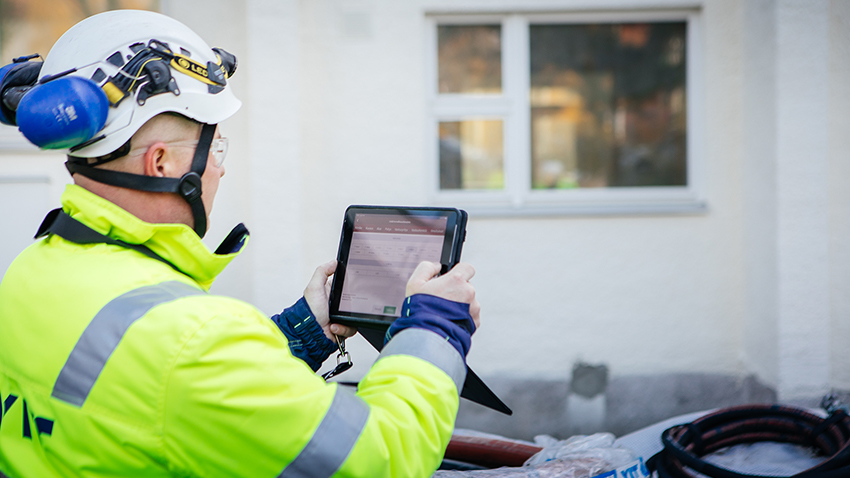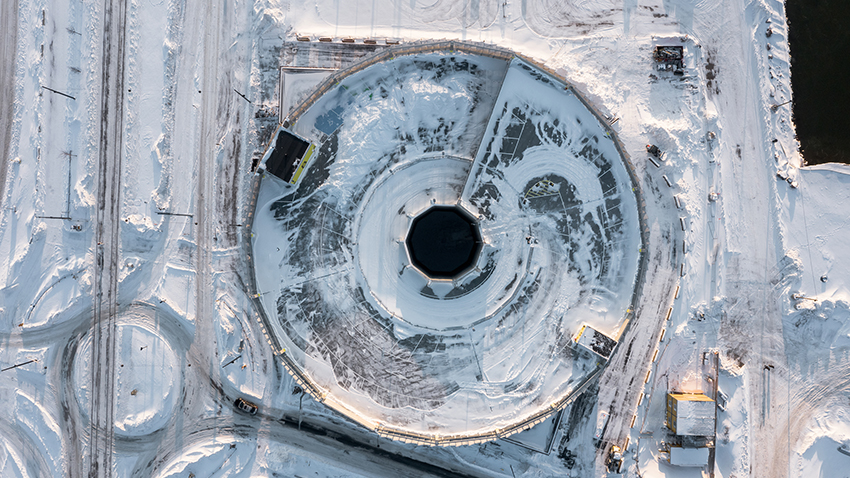Sustainable data centers as a service
The FLOW concept leads construction sites from an avalanche of data towards data stream management
The FLOW concept industrialises construction and simplifies the software chaos on sites with takt production system and related data stream management. In order to be able to manage with data and achieve a high level of automation, the building practice must be standardised and the digital tools supporting the construction must be functional.

The production methods in the construction industry are a hundred years behind other industrial sectors. For example, the industrial production of cars started already in the early 20th century, but construction projects are planned and implemented in a tailored manner still in the 2020s.
However, the construction industry is now taking a huge leap forward in project lead times, productivity and value creation. It has been possible for a long time to standardise production processes, materials, productised structures and digital tools and to copy them to new projects. But how does it work in practice?
Takt production leading to data stream management and automated operations
YIT has surveyed the strategic meaning of supply chains in the construction industry for many years. The Performance programme, which is part of YIT’s strategy, was launched in 2019. The programme aims, among other things, to enhance the productivity of construction without compromising quality by decreasing waste and lead times. A vision of a streamlined end-to-end supply chain, or more specifically industrial construction from design to maintenance, was outlined during the programme. This led to the creation of the FLOW concept, which will create productivity growth in the entire construction industry.
“We recognised that the first thing to be fixed is the production planning and control system with a capability approach. In other words, there must first be a standardised building practice – i.e. production process – and, after that, the digital solution that enables the effective implementation and scaling of the process and, above all, makes working on the site easier,” says Sami Haapoja from Costiom, which is YIT’s partner in the supply chain development.
When YIT started to plan the production planning and control system based on the takt environment, which has been under development for several years, Ari Viitanen from Carinafour was invited to the working group in addition to Haapoja. When digital tools supporting the takt production implementation and scaling into wider use are adopted, we create transparency to the material and resource flows and this way enable management by data. When combined, for example, with the design and financial data flows, this entity produces valuable cumulative data that will enable advanced operations control and automatisation.

From analogue to digital, led by the site
The aim was to develop the FLOW concept in a site-driven manner, which means that a concrete end-product was required as the basis on which to build the system. Parking garage construction was chosen as the platform, as their production was already advanced. A parking garage is also a sufficiently simple construction product, which facilitated the standardisation of operating methods and materials.
The FLOW concept included consideration of how to convert an analogue, human-driven system into an easily scalable format. The objective was to automatise manual data transfer so that the operations on the site will form a single situational picture.
FLOW is literally a stream which aims to maximise the customer value at the end of the stream. The FLOW concept is strongly linked to data collection and analytics in all stages of the construction value chain. When the right things are being metered, it is possible to constantly collect and refine data.
“With enriched data and measuring, we can identify the bottlenecks of the flow and remove them, which will increase the customer value production”, says Ari Viitanen from Carinafour, who is specialised in supply chain optimisation and digital material flow management.

Standardisation offers significant benefits both for the customers and employees
The FLOW concept creates significant benefits for the owner of the work, i.e. the customer, partners and the employees working on the site.
Standardised processes, working methods, tools, materials and close cooperation with the partner network significantly minimise the risk of errors. This guarantees also better quality for the end customer. Simultaneously, waste and CO2 emissions are minimised when the correct amount of material is at the right place, at the right time due to the better production planning.
The concept increases the transparency of the project’s overall situation. The progress of the project and the required decisions can be precisely identified on the basis of the production schedule. This is also reflected as better predictability to the partners and customers.
In the construction site, the FLOW concept creates clarity and understandability in daily work. An individual employee can easily see the entire project schedule as well as the employee’s own tasks and their progress in the control room of the site. Trust at all levels is an important benefit from the employee’s perspective; trust in the schedule and that the prerequisites of work are in order when the materials are in the correct place at the right time and the previous work phase has been completed.

Working methods in order before the work can be managed with knowledge
Producing data is currently not a problem; quite the contrary, there is too much data – even on the sites. It is impossible to manage the avalanche of data or benefit from artificial intelligence environment using the current analogue processes. Therefore, the entire end-to-end chain from design to maintenance and its interfaces must be in order before the old analog production planning, control and measurements can be digitalised. This means standardised work processes and methods.
“Once we have visibility for our production data, we will enter the next phase of managing by data in which we manage the data flows related to whole construction process, remove manual administrative work from the sites and increase automatisation and control through the cumulative data. All this requires a well-standardised building practice,” says Haapoja.
Therefore, we have to take a couple of steps backwards and put the basics of the production process in order. After that, the digitalisation solutions are simple.
Standardisation of operating methods resembles compliance with traffic rules
The target state set by the FLOW concept is a major change for the entire construction industry. When work has been performed project-specifically for decades, the standardisation of working methods may bring a note of discord at the site.
The aim is not to withdraw the possibilities of performing creative work, but, instead, to increase them. Standardisation of work reduces project-specific specification and gives more room to system development and learning from mistakes. Once the basic work and operating models are standardised, the following projects benefit from the previous ones and the working hours saved can be used for innovating new, better working methods. The standardisation of working methods can be compared with shared traffic rules: the traffic flows effectively when the rules are complied with.
Thesis of takt time production in tramway construction
This is how takt production works
Takt production can be compared with production line in which the focus is on the efficiency of the entire production process instead of one individual machine.
- Define the production sequence: who does what, where and in which order.
- Define the order of the work phases and the size of them, for example, by specifying the optimal workstations and intermediate inventories between them.
- Define all information that will be produced in the production chain, in a way that all information is linked to a certain workstation.
- When the entire production chain is standardised, it is possible to ease the processing of data and create rules that enable digitalisation in the production chain.



